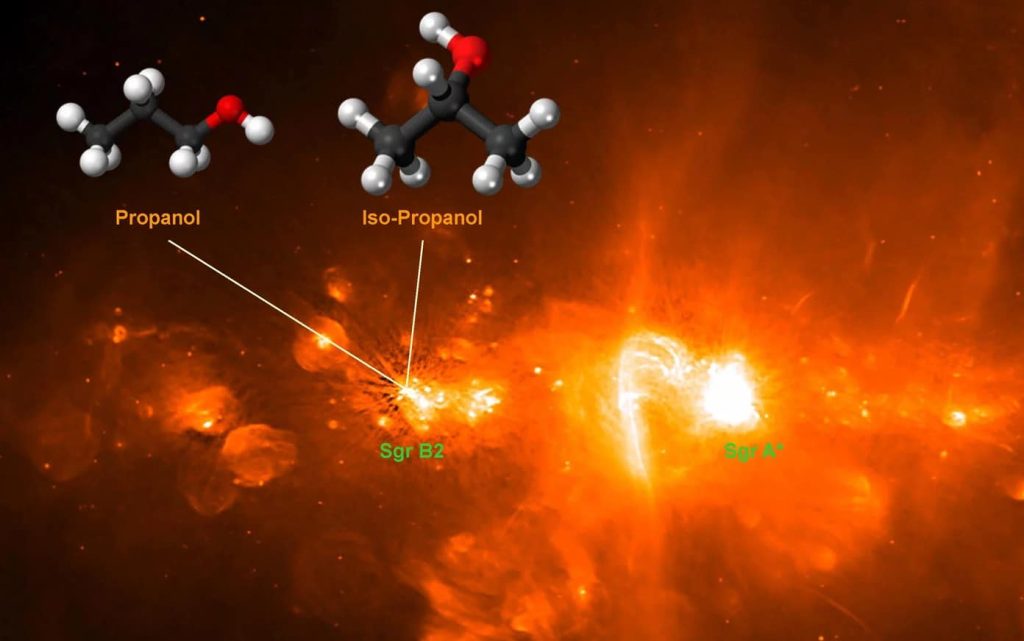
The largest alcohol molecule ever found in space
Researchers at the Max Planck Institute for Radio Astronomy in Bonn have discovered isopropanol for the first time in interstellar space. It is the largest alcohol molecule ever discovered in space. It is observed in the Sagittarius B2 molecular cloud, which is located near the center of our galaxy. This discovery could shed light on the process of star formation.
Astronomers have been probing space for particles for decades. To date, more than 270 molecules have been identified in the interstellar medium. The goal is to understand how organic molecules form in space, particularly where stars are born, and to make connections with the chemical makeup of objects in the Solar System such as comets. The Sagittarius B2 (Sgr B2) cloud, located near the Sgr A* black hole of our galaxy, soon became worthy of this research; Many organic molecules have been discovered there.
” Our group began studying the chemical structure of Sgr B2 more than 15 years ago, using the 30-meter telescope at IRAM. “,” Arnaud Belusch explains, of the Max Planck Institute for Radio Astronomy in Bonn, who was involved in the discovery. Thanks to the Atacama Large Millimeter/submillimeter Array (ALMA), located in northern Chile and commissioned in 2011, astronomers have been able to deepen their research. The high angular resolution and sensitivity of ALMA allowed the identification of new molecules (eg, isopropyl cyanide, N-methylformamide and urea). A new molecule has now been added to the list.
A discovery that would not have been possible without ALMA
Propanol (C3h7OH) is an alcohol that exists in the form of two isomers: propane-1-ol and propane 2-ol (also called isopropanol) – the latter is used mainly in the formation of aqueous-alcoholic solutions and other disinfectants. Beloch and his collaborators recently reported the discovery of these two molecular forms in space. This is the first time that isopropanol has been detected in the interstellar medium, and the first time that natural propanol has been detected in a star forming region.
However, it is not easy to detect organic molecules in the spectra associated with star-forming regions. In fact, each molecule emits radiation at specific frequencies; The larger it is, the more lines it produces at different frequencies. However, the abundance of molecules in Sgr B2 causes the spectra to overlap and entangle—making the identification of molecules more difficult.
But thanks to ALMA’s high angular resolution, it was possible to isolate portions of Sgr B2 that emit very narrow spectral lines – five times narrower than lines detected at larger scales using IRAM’s 30-meter radio telescope. The narrowness of the lines made it possible to distinguish between different radiation frequencies – thus reducing spectral confusion – and to identify two isomers of propanol in Sgr B2.
The discovery of these two very similar molecules, which differ slightly in their structure (the -OH functional group is not placed in the same place), and in particular their abundance, provides insight into the network of chemical reaction that led to their production in the interstellar medium. ” Because they look so similar, they physically behave very similarly, which means that both molecules must be located in the same places and at the same times. Rob Jarrod of the University of Virginia, co-author of the study, explains.
Two groups of similar molecules
The team reports on Astronomy and astrophysics that isopropanol is nearly as abundant as regular propanol, with an abundance ratio of 0.6 – a value similar to that of 0.4 that they previously obtained Isopropyl cyanide (H3against)2CHCN) and its linear isomer, which was also detected in Sgr B2. The researchers note that these results are consistent with those obtained with astrochemical models and that they point to similarities in the chemical processes that make up these two families of molecules.
Since the discovery of isopropyl cyanide in 2014, no other branched molecule has been identified. ” The detection and proportion of natural propanol and isopropanol suggest that the modest preference for the natural form of the previously identified isopropyl cyanide may be a more general feature among interstellar molecules of similar size. ’ concludes the team. In other words, branched carbon chain molecules can be generally abundant in the interstellar medium (as abundant as their linear counterparts).
However, more research is needed to confirm this hypothesis. To do this, astronomers hope to discover other pairs of organic molecules, whose functional group is attached to the primary or secondary carbon of the carbon skeleton. Butanol (which has four carbons) and its three isomers could be the next candidates in the alcohol family. However, detecting them may be more difficult than detecting propanol, the team asserts.
The researchers also note that several spectral lines remain unidentified in the ALMA spectrum of Sgr B2. The radio telescope is expected to soon benefit from lower-frequency extension, which will reduce spectral confusion. Thus, in the near future, other organic molecules can be detected in this giant cloud of gas and dust, revealing the chemical processes that led to the formation of stars.
source : Beloch et al., Astronomy and astrophysics

“Organizer. Social media geek. General communicator. Bacon scholar. Proud pop culture trailblazer.”
